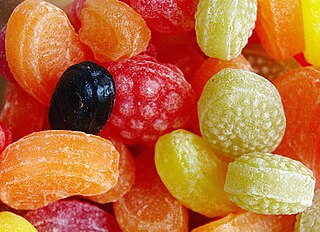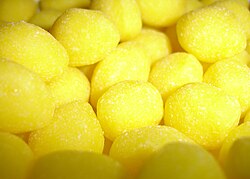
The daiquiri is a cocktail whose main ingredients are rum, citrus juice, and sugar or other sweetener.

Lemonade is a sweetened lemon-flavored drink.

Koskenkorva Viina is a traditional clear spirit drink (38%) in Finland, produced by Anora Group at the Koskenkorva distillery in Ilmajoki and bottled in Rajamäki, Nurmijärvi.

Life Savers is an American brand of ring-shaped hard and soft candy. Its range of mints and fruit-flavored candies is known for its distinctive packaging, coming in paper-wrapped aluminum foil rolls.

Batida is a Brazilian cocktail, and is one of several Brazilian cocktails that are made with the national alcoholic drink cachaça. In Portuguese batida means shaken or milkshake, and the word also means a crash, usually used when referring to a car crash. This beverage is made with cachaça, fruit juice, and sugar. It is blended or shaken with ice.

Chūhai, an abbreviation of "shōchū highball" (焼酎ハイボール), is an alcoholic drink originating from Japan.

A shooter, or shot, is a small serving of spirits or a mixed drink, typically consumed quickly, often in a single gulp. It is common to serve a shooter as a side to a larger drink.

The Fine Art of Mixing Drinks is a book about cocktails by David A. Embury, first published in 1948. The book is noteworthy for its witty, highly opinionated and conversational tone, as well as its categorization of cocktails into two main types: aromatic and sour; its categorization of ingredients into three categories: the base, modifying agents, and special flavorings and coloring agents; and its 1:2:8 ratio for sour type cocktails.

A flaming drink is a cocktail or other mixed drink that contains flammable, high-proof alcohol, which is ignited before consumption. The alcohol may be an integral part of the drink, or it may be floated as a thin layer across the top of the drink. The flames are mostly for dramatic flair. However, in combination with certain ingredients, the flavor of the drink is altered. Some flavors are enhanced, and the process may impart a toasted flavor to some drinks.

A "fizz" is a mixed drink variation on the older sours family of cocktail. Its defining features are an acidic juice and carbonated water. It typically includes gin or rum as its alcoholic ingredient.

There are many cocktails made with cachaça, the national spirit of Brazil. The caipirinha is by far the most popular and internationally well-known, but bartenders have developed other mixed drinks using the spirit.

The paloma is a tequila-based cocktail. This drink is most commonly prepared by mixing tequila, lime juice, and a grapefruit-flavored soda such as Fresca, Squirt, or Jarritos and served on the rocks with a lime wedge. Adding salt to the rim of the glass is also an option.

A hard candy, or boiled sweet, is a sugar candy prepared from one or more sugar-based syrups that is heated to a temperature of 160 °C (320 °F) to make candy. Among the many hard candy varieties are stick candy such as the candy cane, lollipops, rock, aniseed twists, and bêtises de Cambrai. "Boiled" is a misnomer, as sucrose melts fully at approximately 186 °C. Further heating breaks it into glucose and fructose molecules before it can vaporize.

Winter melon punch, also called winter melon tea in East Asia, is a drink made from winter melon and sugar that has been boiled for some time. It is popular in East Asia, especially Taiwan.

A lemon drop is a vodka-based cocktail that has a lemony, sweet and sour flavor, prepared using vodka, triple sec, and fresh lemon juice. It has been described as a variant of, or as "a take on", the vodka martini, but is in fact closer to a daisy or a white lady variant. It is typically prepared and served straight up – chilled with ice and strained.















